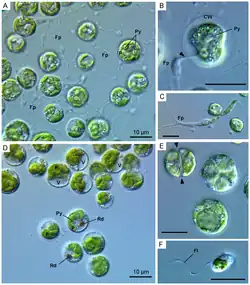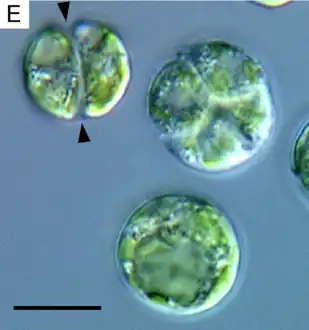Chlorarachniophyte
The chlorarachniophytes are a small group of exclusively marine algae widely distributed in tropical and temperate waters.[3] They are typically mixotrophic, ingesting bacteria and smaller protists as well as conducting photosynthesis. Normally they have the form of small amoebae, with branching cytoplasmic extensions that capture prey and connect the cells together, forming a net. They may also form flagellate zoospores, which characteristically have a single subapical flagellum that spirals backwards around the cell body, and walled coccoid cells.
| Chlorarachniophytes | |
|---|---|
 | |
| Chlorarachnion reptans | |
| Scientific classification | |
| Domain: | Eukaryota |
| Clade: | Diaphoretickes |
| Clade: | SAR |
| Phylum: | Cercozoa |
| Subphylum: | Reticulofilosa |
| Class: | Chlorarachniophyceae Hibberd & Norris, 1984 |
| Orders & Families | |
| |
| Synonyms | |
| |

The chloroplasts were presumably acquired by ingesting some green alga.[4] They are surrounded by four membranes, the outermost of which is continuous with the endoplasmic reticulum, and contain a small nucleomorph between the middle two, which is a remnant of the alga's nucleus. This contains a small amount of DNA and divides without forming a mitotic spindle. The origin of the chloroplasts from green algae is supported by their pigmentation, which includes chlorophylls a and b, and by genetic similarities. The only other groups of algae that contain nucleomorphs are a few species of dinoflagellates, which also have plastids originating from green algae,[5] and the cryptomonads, which acquired their chloroplasts from a red alga.
The chlorarachniophytes only include five genera, which show some variation in their life-cycles and may lack one or two of the stages described above. Genetic studies place them among the Cercozoa, a diverse group of amoeboid and amoeboid-like protozoa.
The chlorarachniophytes were placed before in the order Rhizochloridales, class Xanthophyceae (e.g., Smith, 1938), as algae, or in order Rhizochloridea, class Xanthomonadina (e.g., Deflandre, 1956), as protozoa.
So far sexual reproduction has only been reported in two species; Chlorarachnion reptans and Cryptochlora perforans.[3]
Phylogeny
Based on the work of Hirakawa et al. 2011.[2]
| Chlorarachniaceae |
| ||||||||||||||||||||||||||||||||||||||||||||||||||||||
Taxonomy
- Class Chlorarachniophyceae Hibberd & Norris 1984[6] [Chlorarachnea Cavalier-Smith 1998; Chlorarachniophyta Hibberd & Norris 1984; Chlorarachnia Cavalier-Smith 1993]
- Order Minorisida Cavalier-Smith 2017[7]
- Family Minorisidae Cavalier-Smith 2017
- Genus Minorisa Del Campo 2013
- Species Minorisa minuta Del Campo 2013
- Genus Minorisa Del Campo 2013
- Family Minorisidae Cavalier-Smith 2017
- Order Chlorarachniales Ishida & Hara 1996 [Chlorarachniida Hibberd & Norris 1984]
- Family Chlorarachniaceae (Pascher 1939) Ishida & Hara 1996
- Genus Amorphochlora Ishida, Yabuki & Ota 2011
- Species Amorphochlora amoebiformis (Ishida & Hara 1996) Ishida, Yabuki & Ota 2011 [Lotharella amoeboformis Ishida & Hara 1996]
- Genus Bigelowiella Moestrup 2001
- Species B. longifila Shuhei, Kunihiko & Kenichiro 2007
- Species B. natans Moestrup 2001
- Genus Chlorarachnion Geitler 1930
- Species Chlorarachnion reptans Geitler 1930
- Genus Cryptochlora Calderon-Saenz & Schnetter 1987
- Species Cryptochlora perforans Calderon-Saenz & Schnetter 1987
- Genus Gymnochlora Ishida, Nakayama & Hara 1996
- Species G. dimorpha Ota 2011
- Species G. stellata Ishida, Nakayama & Hara 1996
- Genus Lotharella Ishida & Hara 1996
- Species L. scrobicolata Ishida & Hara
- Species L. polymorpha Dietz et al. 2003
- Species L. vacuolata Ota & Ishida 2005
- Species L. oceanica Ota 2009
- Species L. reticulosa Ohta 2012
- Species L. globosa (Ishida & Hara 1994) Ishida & Hara 1996 [Chlorarachnion globosum Ishida & Hara 1994]
- Genus Norrisiella Ota, Ueda & Ishida 2007
- Species Norrisiella sphaerica Ota, Ueda & Ishida 2007
- Genus Partenskyella Ota et al. 2009
- Species Partenskyella glossopodia Ota et al. 2009
- Genus Amorphochlora Ishida, Yabuki & Ota 2011
- Family Chlorarachniaceae (Pascher 1939) Ishida & Hara 1996
- Order Minorisida Cavalier-Smith 2017[7]
 Lotharella globosa extending a filopodium (Fp) through a pore of the cell wall (CW) from a walled amoeboid cell. Py: pyrenoid.
Lotharella globosa extending a filopodium (Fp) through a pore of the cell wall (CW) from a walled amoeboid cell. Py: pyrenoid.
Scale bar = 10µm Binary and quaternary cell divisions of Lotharella globosa. Arrowheads indicate the parental cell wall.
Binary and quaternary cell divisions of Lotharella globosa. Arrowheads indicate the parental cell wall.
Scale bar = 10µm Flagellate cell of Lotharella globosa with a single flagellum (Fl) and plastid (P)
Flagellate cell of Lotharella globosa with a single flagellum (Fl) and plastid (P)
Scale bar = 10µm
References
- Hibberd, David J.; Norris, Richard E. (1984). "Cytology and ultrastructure of Chlorarachnion reptans (Chlorarchniophyta Divisio nova, Chlorachniophyceae Classis nova)". Journal of Phycology. 20 (2): 310–330. doi:10.1111/j.0022-3646.1984.00310.x. S2CID 86059445.
- Hirakawa; et al. (2011), "Morphological Diversity between Culture Strains of a Chlorarachniophyte, Lotharella globosa", PLOS ONE, 6 (8): e23193, Bibcode:2011PLoSO...623193H, doi:10.1371/journal.pone.0023193, PMC 3156133, PMID 21858028
- Brodie, Juliet; Lewis, Jane (26 November 2007). Unravelling the algae: the past, present, and future of algal systematics. CRC Press. ISBN 9780849379901.
- Keeling PJ (2009). "Chromalveolates and the evolution of plastids by secondary endosymbiosis". J. Eukaryot. Microbiol. 56 (1): 1–8. doi:10.1111/j.1550-7408.2008.00371.x. PMID 19335769. S2CID 34259721.
- Nakayama, Takuro; Takahashi, Kazuya; Kamikawa, Ryoma; Iwataki, Mitsunori; Inagaki, Yuji; Tanifuji, Goro (2020). "Putative genome features of relic green alga-derived nuclei in dinoflagellates and future perspectives as model organisms". Communicative and Integrative Biology. 13 (1): 84–88. doi:10.1080/19420889.2020.1776568. PMC 7518460. PMID 33014260.
- M.D. Guiry (2016), "Chlorarachniophyceae [Chlorarachnea]", AlgaeBase, World-wide electronic publication, National University of Ireland, Galway, retrieved 25 October 2016
- Cavalier-Smith (2017), "Kingdom Chromista and its eight phyla: a new synthesis emphasising periplastid protein targeting, cytoskeletal and periplastid evolution, and ancient divergences", Protoplasma, 255 (1): 297–357, doi:10.1007/s00709-017-1147-3, PMC 5756292, PMID 28875267
External links
- AlgaeBase: Chlorarachniophyta
- Systematic Biology: Chlorarachniophyta
- Systematic Biology: Cercozoa Archived 2015-04-02 at the Wayback Machine
- Tree of Life: Chlorarachniophyta